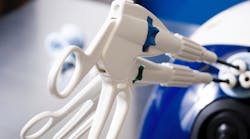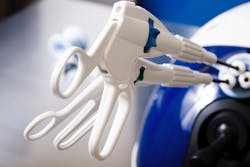Friction and wear can impact a medical device’s performance in the operating or treatment room…especially if the device does not function precisely, predictably and efficiently to complete a procedure. Also, during manufacturing and assembly, tight-fitting parts can make device production difficult and slow. So, it is important to think about lubricating coatings in the early stages of design to mitigate these factors. Determining the best parts lubricant for the device can help improve both production throughput as well as the completed device’s performance.
Medical Grade Coatings
There are many medical-grade lubricants on the market today to help address device friction and wear, including silicone oils and greases. Dry lubricants are also a popular choice. These dry coatings reduce the combination of friction and sticking, or “stiction,” on parts that slide, shear, twist, rock or pivot. Moving mechanisms like these are most often found in disposable medical devices such as catheters, cutting tools, staplers, hypo tubes and other surface to surface assemblies.
Dry lubricating parts typically reduces actuation forces by 25-30%. This allows the parts to move more freely and improves their performance. Without the use of a dry lubricating coating, many of today’s complex medical devices would not be a viable option.
As well as using lubricating medical device parts, dry lubricants can also be used on the manufacturing and assembly equipment itself. To run more smoothly, a clean, long-lasting dry lubricant is applied to production paraphernalia such as chains and pulleys, chutes and slides, door tracks and conveyors, and other metal extrusions. Dry lubricant can also serve as a release agent for molded parts.
What is a PTFE-Based Lubricant?
Many dry lubricants use polytetrafluoroethylene (PTFE) that is suspended in a high-purity nonflammable carrier fluid for dilution and dispersion. Dry PTFE lubricant works particularly well on high-speed, high-volume mechanical assembly production fixtures to speed the assembly of plastic and metal components. It also helps the parts tolerate exposure to water, oils, chemicals, abrasion and high temperatures.
A thin layer of this non-stick solution is applied to the parts. The lubricant’s carrier fluid then quickly evaporates, leaving a smooth, even dry coating on the treated part. The carrier fluid that delivers the lubricant should have low viscosity to wet and conform to the treated part’s surface geometry. This helps provide a highly consistent surface coating without leaving unwanted residue, staining, drips or runs that could disguise any Unique Device Identification (UDI) markings on the device.
Applying Dry Lubricants
The typical application techniques for applying dry lubricants inside a carrier fluid dispersion include dipping, spraying or wiping.
Dipping. This is commonly used in high-volume production since it adds a consistent coating to nearly any surface shape or size, including small, complex parts such as wire coils. Conveniently, entire finished devices can also be dipped into the carrier fluid dispersion. Normally a single immersion is enough, but the coating level can be adapted by adjusting the concentration of PTFE particles in the fluid, the rate of withdrawal and number of applications.
Wiping. Wiping or brushing is mostly used in medium- to small-batch production. Because this method covers longer, ongoing surfaces, it is ideal for components like rods, tubing or sheeting. However, it can also be used if only a small, select area of a larger part requires coating. Once brushed on, the carrier fluid dries rapidly, leaving a consistent, even and thin coat of dry lubricant behind.
Spraying. Spray application is done using a hand-held spray gun or automatic spray heads. Spraying is typically used to apply a number of thin coats, allowing the surface to dry between applications. Applying several coats over time is a better technique than one single thick coating, as the thicker coating takes longer to dry and can cause uneven coverage and poor adhesion.
Following application, the durability of the PTFE-based dry lubricant coating can be improved through heat curing or melt coating. This fuses the lubricant to the part, giving it a harder, more-permanent surface. Heating or melt coating also turns the dry lubricant completely clear, leaving an invisible coating. It’s always a good idea to consult your coatings provider to get a recommendation on which process is best for the particular application.
Choosing a Dry Lubricant
When choosing a dry lubricant, there are some important features to look for.
ISO 10993 certified. Dry lubricants can typically be applied in-house within the production and assembly process, saving both time and money. In addition, using a dry lubricant that is ISO 10993 certified as a medical-grade lubricant makes it easier to add to production validation processes.
Non-migrating. Many lubricants like grease and oil can be expensive, messy and difficult to apply. The also often migrate to other surfaces or to product packaging. This makes facility cleanliness more challenging and process validations more complex. On the other hand, dry lubricants are clean, easy to apply and don’t migrate after application. This makes for a cleaner production or cleanroom facility and eases validation.
Nonpyrogenic. A non-aqueous carrier fluid helps prevent bacterial growth and other biologic contamination to the parts or devices.
Compatible. PTFE-based dry lubricants have excellent materials compatibility. They are safe to use on metal, glass, plastic and ceramic parts, so they are ideal for medical devices made with mixed material components. Dry lubricants are also typically compatible with commercially used EtO (Ethylene Oxide) and radiation sterilization processes.
Don’t Forget Your Coat
Medical device engineers and manufacturers must consider the lubricant coating process carefully when designing and producing medical devices. A dry lubricant contributes not only to the efficient production of the parts but also to the functionality, quality and consistency of the finished product.
Moving away from traditional silicone oils and greases and switching to a PTFE-based dry lubricant can be beneficial. It not only works well to increase the overall performance by reducing stiction, but also addresses the long list of requirements when manufacturing medical devices. From validation conditions and bioburden risk to safety concerns, materials compatibility, and reliability and consistency.
Some medical devices would never reach their potential without the properties offered by dry lubricant coating technologies. So, selecting a lubricant coating early in the planning stage of a medical device design is critical to its success.
Jay Tourigny is senior vice president at MicroCare Medical, which offers medical device cleaning and lubricating solutions. He has been in the industry more than 30 years and has a BS from The Massachusetts College of Liberal Arts. Tourigny holds numerous U.S. patents for cleaning-related products that are used in medical and precision cleaning applications.



